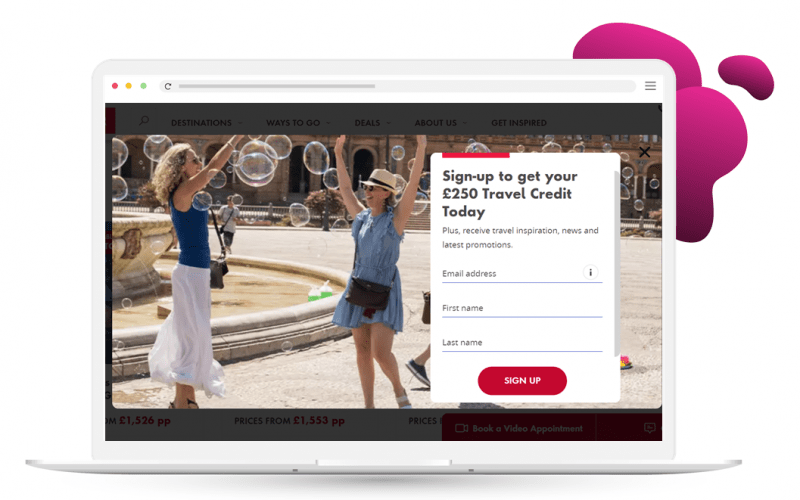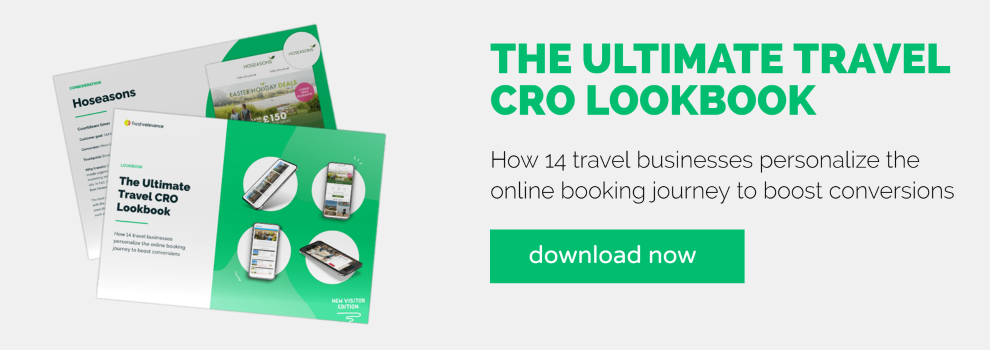Even those holidays planned on a shoestring budget tend to exceed what consumers would spend on an average day. Whether going abroad or staying closer to home, consumers want to feel confident that their vacation is going to meet their expectations, and ultimately be one they enjoy. As a result, most bookers extensively research, compare and consider the options available before making a purchase decision.
The pressure to choose the right holiday can often lead to hesitation when it comes to completing the final hurdle of booking. Whilst purchase anxiety may be a good outcome for a consumer’s bank account, it presents a significant challenge for travel marketers seeking to increase revenue by combating website bounces and improving visitor identification.
In order for travel marketing to nudge customers towards booking with them, the travel industry must find ways to identify more website visitors and engage them using a combination of web and email marketing within their marketing efforts. By sending highly relevant and targeted emails once a shopper has left the website, travel marketers are in a much stronger position to take consumers from consideration to conversion. Email also helps travel companies develop a relationship with the customer that drives loyalty and repeat bookings.
One way businesses in the travel industry can entice customers to share their email is through displaying a data capture pop-up or banner on the website, helping to collect that all-important first-party data so that companies can use personalization. After viewing the website for a certain amount of time or upon exiting it, visitors are invited to enter personal information – such as an email address and other details, like the types of holiday they prefer. From this and behavioral and contextual data collected about the booker, marketers can immediately begin to tailor emails to what is likely to capture the individual’s interest.
Pop-ups have had their fair share of criticism in the past. If served immediately once a customer has landed on the homepage, they can be perceived as irritating and have the them looking for the “X” button straight away.
The key is to use data capture popovers to enhance the customer experience, rather than take away from it.
When deployed in a smart way, popovers are a powerful tactic that can persuade customers to share their valuable data, helping to grow your email list and ultimately generate more sales within your travel marketing. With that in mind, we’ve looked at the key considerations travel marketers should keep in mind when implementing or updating their data capture strategy.
Make sure timing and design are right
For maximum impact, it’s important that companies within the travel and tourism industry leave a bit of time for customers to browse the website before serving a pop-up that asks for customer data. The best way to get the timing right is to serve popovers in response to browsers’ behavior. To work out whether to use a popover – and what content to include – consider the shopper’s interests, lifecycle stage, and place in the buying journey.
A dynamic popover layout will help avoid interrupting the customer journey. For example, the overlay can sit at the bottom of the window as shoppers move through the website, with the sign-up box remaining hidden until a visitor chooses to expand the popover.
Use enticing call-to-actions
To maximize engagement, include a compelling call to action and clearly show the value you’re offering. If done right, customers will be more likely to use their valuable time to fill in your travel business’ form.
In the example below, Six Star Cruises make use of a popover to collect valuable customer data. They also use an enticing offer, by adding that by singing up, you could save up to £6,300 per couple.

Source: sixstarcruises.co.uk
Keep content relevant
In the pop-up, brands in the travel industry could also gather zero-party data, for example asking visitors about their favorite destinations or types of holiday, such as family vacations or couple retreats. This allows marketers to deliver relevant content even to those shoppers who haven’t provided a lot of browsing and booking data yet. Using the provided preferences, brands could highlight and recommend hotels offering a kids club in their marketing for shoppers interested in family vacations, and wellness hotels for bookers looking for a romantic getaway.
However, it’s important to get the balance right – don’t ask shoppers for too much information as this is likely to deter them from submitting any information at all. Once marketers have a visitor’s email address, they can then follow up to get more customer information and get to know them better.
In the example below, Trafalgar use a popover with a relevant deal on travel credit for the company, allowing customers to have a discount on their travels, enticing them to give their details.

Source: trafalgar.com
Don’t choose a one-size-fits-all approach
The more tailored a pop-up is to the website visitor, the more likely it is going to resonate. Consider delivering different data capture pop-ups to different customer segments. For example, you could tailor the data capture device to the visitor’s traffic source and show different pop-ups for direct traffic compared to shoppers who came to the website through Google AdWords. Also consider tailoring the pop-up content to the visitors’ interests, for example reflecting the destinations or types of holidays featured on the currently viewed page.
Popovers based on exit intent are a great tactic to keep shoppers engaged. These popovers can’t push a visitor away from your website as they’re already leaving, but might persuade them to stay in touch. When a customer is about to abandon a booking, an overlay can be triggered offering to send them an email reminder of their cart.
As a company in the travel industry, you can even use a popover to remind customers who have previously browsed and left your website what they were looking at. Cottages.com does this in the example below, allowing returning visitors to return to where they left off, enticing them to make that purchase. The popover is non-intrusive, and can easily be clicked away if the consumer decides they would rather start from scratch.

Source: cottages.com
To give shoppers a personalized experience across web and email, it’s important to identify as many visitors as possible. By effectively using data capture pop-ups and banners, travel brands are in a unique position to build their email list, shorten the booking process and encourage loyalty, as well as being able to listen and respond to valuable customer feedback.







